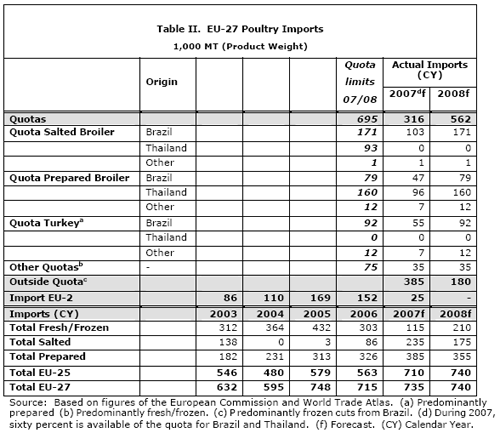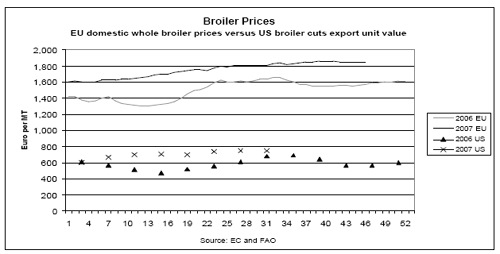



Netherlands Poultry and Poultry Products- Opportunities on the EU Poultry Meat Market
By USDA Foreign Agricultural Service. This report is the result of collaboration with the following FAS colleagues: Xavier Audran from FAS Paris covering France; Bob Flach from FAS The Hague covering the Benelux; Mike Hanley from FAS Dublin covering Ireland; Hasse Kristensen from FAS Copenhagen covering Denmark; Sabine Lieberz from FAS Berlin covering Germany; Yvan Polet from FAS Brussels U.S. Mission to the EU.EU Poultry Trade
EU Poultry PSD

Background on EU Poultry Imports
The EU is currently a net exporter of poultry meat but the gap between imports and exports is closing (see Table II and graph below). In 2003, EU imports, mainly originating from Brazil and Thailand, surged to 632,000 MT. Most of these poultry products were imported under HS code for salted poultry meat, HS 02109939, which had a lower tariff rate. In response, the European Commission (EC) imposed a higher tariff for salted poultry meat imports. This had a clear negative effect on imports in 2004. During 2006, imports suffered from the Avian Influenza (AI) outbreaks in the EU. As a consequence of the outcome of an arbitrage procedure with the WTO, Brazil was able to resume poultry exports with the lower tariff as from end of June 2006. With the accession of Romania and Bulgaria to the EU an import volume of about 150,000 MT was terminated (see Table I, II and GAIN Report E47061).
Anticipated EU Poultry Imports
As from June 2007, Brazil and Thailand were able to resume poultry exports under the lower tariff rate, filling the negotiated import quota (see GAIN Reports E36137 and E36143. During the second half of 2007 and the whole year of 2008, EU import quotas are expected to be filled (see Table II). An exception is the quota for salted broiler meat from Thailand, due to the AI status of country. With the implementation of the tariff quotas, traders expect EU poultry imports to stabilize (see Table II and GAIN Report E47061).

Expansion of imports outside the quota is hindered by a tariff rate of Euro 1 per kg. During 2006, however, EU domestic broiler prices rose continuously (see graph below), which could eventually lead to more imports paying the full tariff rate. The EC forecasts that EU poultry consumption will outpace production after 2013, and as a consequence the EU will become a net importer of poultry meat (see EC Report “Prospects for Agricultural Markets and Income in the EU”; EC Report). For 2008, however, traders expect limited imports against growing demand and thus higher prices and more opportunity for high value special products and/or cuts, such as from the United States.
In May 2007, the EU opened a poultry TRQ for the United States (see GAIN Report E47039). Commission Regulation 536/2007 makes a 16,665 MT U.S. country-specific poultry TRQ available, which was agreed as a compensation for the EU enlargement of 2004. This TRQ is available for chicken and turkey meat and offers duty free access for high quality cuts to EU certified exporters. The EC is, however, still imposing a ban on the use of anti-microbial treatments for sanitizing poultry carc asses, effectively halting U.S. poultry exports to the EU (see GAIN Report E35166.
EU poultry Exports
EU poultry exports show a declining trend, which is expected to proceed (see EC Report). This expectation is based on the fact that EU exports face strong competition on the world market, while EU domestic consumption is expanding. EU producers have difficulty to compete due to the relatively high feed prices. Since August 2005, Dutch broiler feed for fattening rose continuously from Euro 229 per MT to Euro 334 per MT currently. Furthermore, the EC stopped the export refund for chicken parts in October 2006. At the moment, only refunds exist for the export of whole broilers. EU poultry exports are mostly destined to Russia, the Middle East, and African destinations, which each hold about a quarter of total EU poultry exports. On the Russian market, EU exports have a stable share of about fifteen percent of total imports, with the U.S. and Brazil as the most important competitors. About thirty percent of EU poultry exports is exported to the Middle East and Asian destinations, at equal shares.


List of Articles in this series
To view our complete list of 2007 Poultry and Products Annual reports, please click hereDecember 2007








